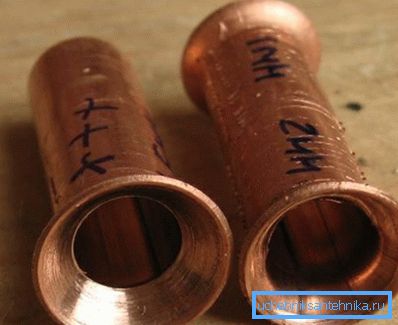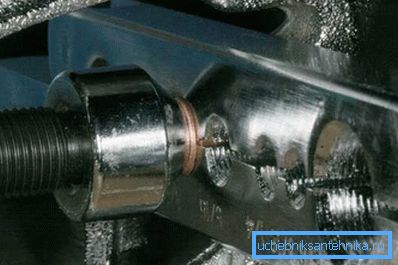Flaring copper pipes: review available tools and methods
Pipe flaring or rolling is the deformation of the material from which they are made in a certain direction. Rolling is advisable in the case when the finished cast or stamped product can not be purchased or made the right size and shape.
Another reason for the application of this method may be the need to adjust the internal diameter of the pipe to the desired size.

Basic concepts
Rolling is often used in systems in which elements are connected using sewer couplings or soldering. These are systems such as water, heating, gas, cooling, air conditioning, or mechanical engineering. If we are talking about such a process as flaring steel pipes or copper on an industrial scale, then for this process using specialized shafts, rolling on the surface several times to create the desired diameter.
A special case of rolling may be the operation of a pipe bender, which the installers of plumbing or gas equipment must have come across. In this tool, the roller rolls the pipe around the shape of a given radius, creating a bend of the required parameters.

Why need rolling
Flaring the tubes with your own hands is a procedure that is necessary in the following cases:
- To buy a tube of the required size is not possible due to the fact that products with specified parameters are not made by casting and stamping methods;
- To assemble the system, an exact fit of the elements to the size is necessary, in accordance with certain parameters of the bending angle or internal diameter.
Rolling of the copper pipes participating in creation of water supply system belongs to the last case.
The implementation of the rolling method

The flaring of copper pipes with your own hands is a procedure that certainly requires the use of a specialized tool.
The plasticity of such a material as copper allows a person who is physically developed and dexterous enough to simply try to pull such a tube on a conical shape with his own hands, but this is fraught with the following consequences:
- A thin tube with the implementation of this method is easy to hush up;
- In a place where there is a maximum effort, the tube can simply break.
Council This method of stretching is considered rather rough and is used only in extreme cases.
Between such a barbaric method of stretching and a good rolling, which is used by a flare for copper pipes, there is an intermediate option - a device with interchangeable nozzles or an expander. This device allows you to stretch the soft copper material with a lever in just one simple action.

Note! The flare expander is a convenient device, its speed is decent, but the quality of the result leaves much to be desired.
The most appropriate tool for flaring is a roller made of a carbide material that repeatedly rolls over the internal diameter of the pipe being laid. With each rental of a given roller, the deformation of the tube will be stronger in a given direction.
Benefits of using a roller
Flaring a copper pipe with your own hands using a roller is a process that is characterized by the following characteristics:
- Tears of the pipe being processed are excluded.. Each rolling roller is accompanied by a slight deformation of the product, and the gradual deformation is easily transferred by the metal, which eliminates ruptures;
- The wall thickness of the tube after flaring remains uniform. The thickening in the pipe walls, if it was initially heterogeneous in composition, will be rolled out to a uniform thickness with the help of rolls;
- After flaring the surface will be perfectly flat and smooth.. Such smoothness directly depends on the quality of the tool used.
Note! You certainly have the opportunity to purchase a lower-quality tool, the price of which will be lower. Such a product has a contour that is simply pressed into the pipe in a fixed position. The result after working such flaring will be somewhat worse, but quite acceptable.
The use of a flare

The flaring of the copper tube with the help of a flare hand is performed if the connection is made with the help of couplings or by soldering. When soldering, it is necessary to expand one end into which another tube is inserted.
Thus, there is a small gap that must be filled with solder. This type of connection is considered the most reliable for the installation of a split system and refrigeration units.
Coupling connection is also quite popular due to the fact that it is fairly easy to assemble and disassemble such a system. Before embarking on the flaring of the tube for installation with the help of couplings, it is necessary to first prepare it, and only then begin the deformation.
The order of work is as follows:
- Cleaned end of pipe:
- A sleeve is put on the pipe;
- The tube is inserted into the instrument. The flaring screw rotates until the edge forms an angle of 450;
- The product is removed from the tool;
- The clutch is led to the edge and the nut twists on it.

Council Many craftsmen recommend cutting pipes with a margin of 2-2.5 cm when installing the copper pipeline so that in case of unsuccessful flaring the end of the pipe can be cut off and duplicated the process of rolling.
If the installation of the pipeline will be carried out by soldering, then the rolling process should consist of the following steps:
- The surface is cleaned with a special brush;
- With the help of rolling, the pipe expands so that it can be inserted into the next element of the system with a gap of 0.1 mm;
- It is necessary to apply a flux on the inner surface with a uniform layer and connect it with the next network element;
- The junction is heated with a burner, and solder is brought to it. Warming continues until the solder melts;
- Heating continues until the molten solder is distributed evenly across the joint.
Finally

From the point of view of modernity, the copper pipeline due to the complexity of its installation and the alternatives existing in the modern market, is a rather strange choice. However, if you nevertheless decided to create a pipeline from this soft material with your own hands, then you can easily cope with the installation of such a system with the help of flaring (see also the article The VChGG Pipes - features and application).
A video in this article will allow you to read the instructions of this type of installation.